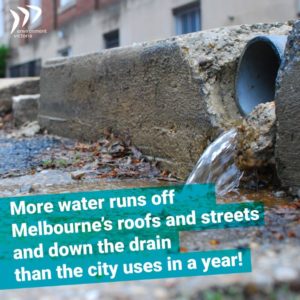A whopping 440 billion litres of storm water is available for re-use every year, even under dry conditions – more than the City’s current consumption of around 400 billion litres. Add to that the more than 400 billion litres of treated waste water that is available for recycling and reuse and the water crisis evaporates.
This summer in Melbourne has been dry and last winter wasn’t flush with rainfall either. We’ve all noticed our gardens drying out, our parks turning brown and reservoir levels dropping.
The Andrews Government’s first response has been to turn on the desalination plant to supplement our water supplies. This is Victoria’s most expensive and energy intensive water which should be a last resort, not a first option when the going gets a little bit tough.
Disappointingly, the Andrews Government is choosing to ignore Melbourne’s best-kept secret – more water runs off our roofs and streets and down the drain than the city uses in a year!
More water runs off our roofs and streets and down the drain than the city uses in a year!Click To Tweet
A whopping 440 billion litres of storm water is available for re-use every year, even under dry conditions – more than the City’s current consumption of around 400 billion litres. Add to that the more than 400 billion litres of treated waste water that is available for recycling and reuse and the water crisis evaporates.
Melbourne does not suffer from lack of water, we just fail to make use of all the water that is available to us.
This was clearly recognised by the previous Coalition government in their Melbourne’s Water Future strategy:
‘The existing framework of policies, institutions and regulations reflect an out-dated model of planning, managing, delivering and using water. We are paying too much to build big infrastructure like the desalination plant, and we can no longer afford the energy and infrastructure costs of piping water around Melbourne when we could be better off using and reusing the rain that falls on Melbourne and the stormwater runoff generated by that rainfall.’
Unfortunately the Coalition failed to implement this approach and instead scrapped water conservation programs that had been working well like water restrictions and Target 155.
Stormwater running into our rivers and creeks is causing erosion, reducing water quality and impacting on flow regimes. Capturing it for use and retaining it in the landscape to support local vegetation and recharge soil moisture would provide an enormous boost to liveability as well as improving river health.
The Andrews government is currently working on a new State Water Plan with a draft due for public release shortly. This is a golden opportunity establish a plan for water-sensitive towns and cities throughout the state. Key planks of the plan should include:
- Capturing stormwater runoff to increase water availability, improve liveability and reduce damage to urban creeks and rivers
- Improving rates of water recycling – currently only 16% of treated water is reused
- Embedding water efficiency into new and existing homes and businesses
- Comprehensively integrating water cycle management and water sensitive urban design into the planning framework
The government’s reintroduction of Target 155, a voluntary target for household water conservation of 155 litres per person per day, is a great start. Many of our water-saving habits developed during the Millennium drought seem to have been forgotten. Over time the target could be tightened to 100 litres/person/day, on the proviso that households could use as much recycled water or stormwater as they require.
With an expanding population and a drying climate, Melbourne is facing an enormous challenge to meet its present and future water needs. We are already squeezing our rivers systems dry and relying on expensive and energy-intensive desalination. This is not the answer. We need to be making use of every drop of water that is available to us and capitalise on the untapped resources that are literally under our noses – storm water and recycled water. At present they are being wasted down the drain and out to sea. This has to stop.